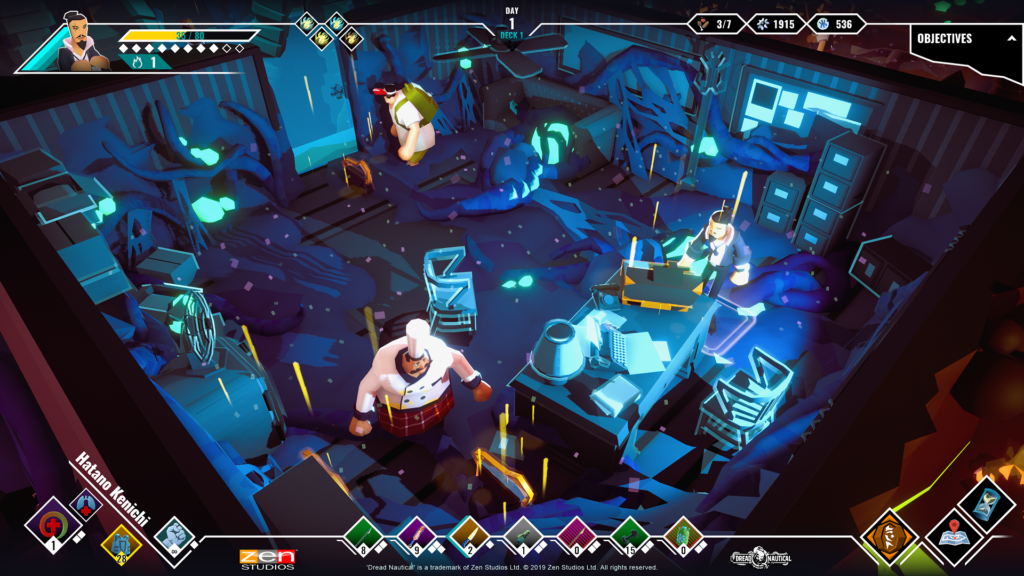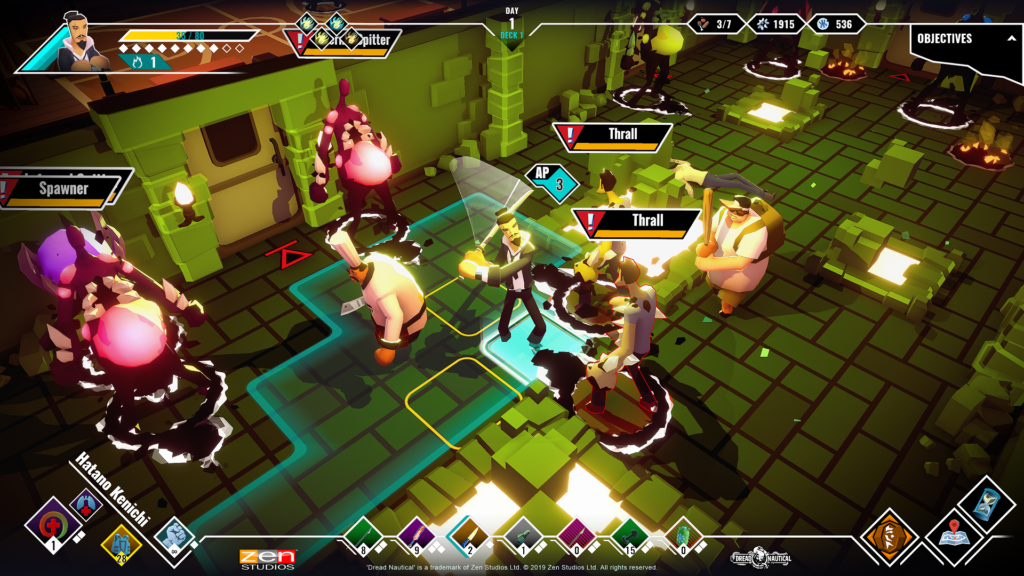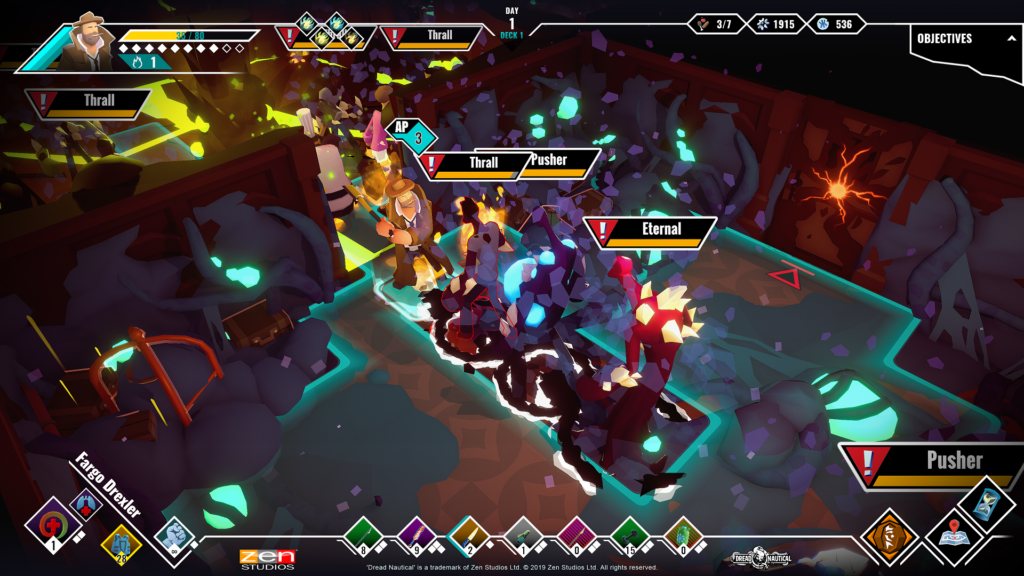Dread Nautical, by developer ZEN Studios, is a turn-based strategy game. In it, you lead a group of survivors on a cruise ship stuck in an alternate world infested with monsters and zombies.
When you start the game, you pick from one of 4 characters to be your “main” character. This character is the one that will talk to other survivors. Also, if your main character runs out of hp, you will restart in the ship’s lobby. Depending on the game’s difficulty, the day will be reset (normal), you will lose everything you were carrying and the survivors that accompanied you will need to be found again (hard), or you will need to start from the beginning of the game at square 1 (insane).

In the ship’s lobby, you can talk to other survivors, repair/upgrade weapons and gear, level up survivors, upgrade one of the stations, or take the elevator to one of the decks on the ship.
Each time you visit a deck, its layout is randomly generated, even if you have already visited that deck before. While you are occasionally given side objectives, most of the time the goal is to get to the front of the ship to sound the foghorn. Why there’s a foghorn on every deck of the ship, I have no idea (its one of those things that you just don’t question). When you sound the foghorn, your group blacks out and reawakens the next day in the ship’s lobby, with the next deck becoming unlocked. All the scraps, runes, and food you gathered on that deck will be added to your total. Finally, you will distribute food among the survivors.
Combat in the game is fairly similar to other games of its type. Your characters have a set number of action points every turn and moving or attacking uses up those action points. A thing to consider is that weapons have different action point costs, so while some can be used multiple times, others can usually only be used at most once per turn.

Whenever you visit a deck on the ship, you choose up to 2 survivors to accompany your main character, as well as what weapons and gear the 3 characters will take with them. You can gain new weapons by picking them up on a deck, but you only have a limited number of inventory slots. Each survivor, including your main character, starts with just 3-4 inventory slots, but this number can be upgraded by leveling up the character via the occult station on the ship’s lobby. Gear can only be picked up by exchanging it for the piece of gear the character is already wearing. Also, you will only take back what weapons and gear your characters are carrying when you sound the foghorn. Everything else, whether you started with it when you came on the deck or not, is lost once you sound the foghorn. A saving grace is that key items, such as keycards, don’t take up any inventory space. Gathered resources also don’t take up inventory space.
There are 3 resources in this game: scraps, runes, and food. Scraps are used to upgrade the various stations in the lobby and to upgrade/repair weapons and gear. Runes are used to level up survivors at the ship’s occult station. There is a limit to how high you can raise the level of a survivor, the limit is increased every time you use scrap to upgrade the occult station. Food’s use is fairly straight forward, you need to give the survivors food every day to keep them from going hungry. Not feeding a survivor won’t kill them immediately, but it will reduce their stats if you try to take them with you. Luckily, at least on normal difficulty, exploring the deck will give you just enough food to feed all your survivors.

While you start the game with just your main character, you can recruit other survivors aboard the ship to join you. To do this, you need to talk to the survivor in question and choose a response that you think will satisfy them. If they are satisfied with your response, their approval rating will go up. Once their approval rating is at about 80%, they will ask if they can join you. Every survivor starts with 50% approval, so usually if you just give them 2-3 “correct” responses, their approval will be at 80%. If you have enough beds in the lobby, you can invite them onto your team. You gain beds by using scrap to upgrade the dormitory found in the ship’s lobby. If you don’t have enough room or for some reason don’t want to recruit them, you can turn them away. To be able to re-recruit them, you will need to again find them and give them a response they like.
Occasionally, the survivors will give you a side quest to complete. Obviously, completing it and then talking to them boosts their approval rating, usually more than appeasing them with “correct” dialog responses. These side quests can only be completed on the deck they were given to you.
You can only talk to a survivor once a day so you will likely need to seek the same survivors out on different decks to get them to join you. The exception to this rule is being given side quests. When you are given a side quest, you are allowed to talk to the survivor a second time to tell them you have completed the quest. Every survivor you have encountered in the past will be present on the next deck you unlock, so finding them isn’t a matter of memorizing the deck you last saw them on. However, their health carries over, so they can die if you take too long to recruit them.
While the main character obviously needs to stay alive the entire game to carry the story, the other survivors on your team can permanently die. They will die if they run out of health while on a deck with you, if they go too long without getting food, or if they are outside the room with the foghorn when you sound it. Also, as previously mentioned, survivors you haven’t recruited keep a constant health value, meaning if they take damage from an enemy, their health will be the same as it was the last time you saw them.
Overall, I enjoyed my time with this game. As such, I think a fair rating for it is 8/10.
Check Out the Dread Nautical Trailer:
Dread Nautical releases today for Xbox One, PlayStation 4, Nintendo Switch, and PC via Epic Game Store.
For more information, please visit: www.DreadNautical.com
Xbox One Review
I am a recent Computer Science/Game Development Programming Chapman University Graduate. I am a life long enthusiast of computer/video gaming and my favorite game genres are adventure, choice-driven stories, fighting, and racing. My favorite game/movie series include but aren't limited to 'Legend of Zelda'; 'Dragon Age'; 'Persona'; 'Sonic the Hedgehog'; 'Mario'; 'Metroid' ;'Megaman'; 'Naruto'; 'Batman'; 'Spiderman'; 'Star Wars'; and 'Star Trek.'





More Stories
DAIMON BLADES Preview for Steam Early Access
ReStory Preview for Steam
Firefighting Simulator: Ignite Releases Parker’s Story DLC for PC and Console